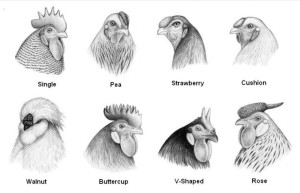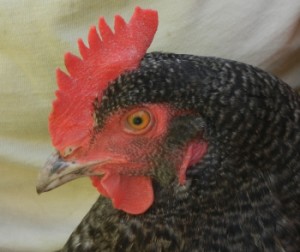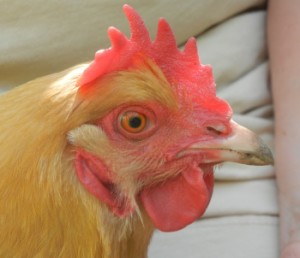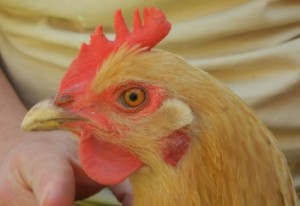The chicken comb and wattles help keep the chicken cool. Blood circulates through the comb and wattles cooling off as it passes close to the skin surface. Combs vary in size, shape, and color based on the age, sex, and breed of a bird. Chicks will begin to grow a comb within the first few weeks after hatching. When Henny started growing her comb and wattles, Denise panicked, as they were getting very large. She ran to her computer to look up images of Henny’s breed in order to look at the shape and size of the hen combs and wattles, and she sighed with relief to see that the hens had very large combs. Roosters of the any breed have much larger and brighter combs and wattles than the hens, and yes the bright colors and size are for looks, most females can’t resist all that red. Comb color can be a variety of reds to purples.

The breed of a chicken determines the shape and color of the bird’s comb. And WOW there are some crazy shapes, plus breeders are producing interesting combined shapes when they crossbreed. Check out some of the shapes in the illustration.
The parts of the comb are: the base (attached to the head), the serrations or points (usually 5 or 6, of which some can be rather deep), the blade has a front, middle (both of which are attached to the head), and posterior (often not attached to the head).

Henny, Penny, and Sky all have the Single comb shape, but each of their combs is different, while their wattles are very similar. The ear is also bright red and can be quite fleshy (located straight back from the bill and surrounded by small feathers). Note in the pictures that the ear is a different shape for all three hens, as is the comb.
Hope you enjoyed the education on the chicken combs, wattles, and ears. Oh and those ears work really well. If the hens hear the back door of the house open they come running across the yard or come out of the coop and into their run to beg, with the assumption that the human has food. Denise tries to sneak out of the house without stirring the chickens, but it rarely works.

Other updates – the rains are finally letting up and Denise has been busy turning the soil over in her garden plots for planting. Peas are in and starting to come up. The girls have been helping Denise rid her soil of those pesky earth worms. But they eat just about anything and gulp down the slugs hiding there too. Since Denise can over do it in the garden and strain her back, the girls make sure Denise works very slowly and careful by placing themselves right under her shovel as they look for things to eat. Thus slowing down Denise’s work a lot as she tries not to stab her chickens. Mostly the work is Penny’s, for she is the boss and therefore gets first crack at the worms, sometimes before the dirt is even dumped off the shovel. Since Penny can get a bit mean over the worms (she once took a mouthful of tiny feathers out of the top of Sky’s head), Denise keeps moving between plots so that all three chickens get to eat worms, Penny is right on Denise’s heels following her to a new plot and fresh worms.

Overall, Penny has calmed down quite a bit and rarely gets pushy or pecks the other two girls. And Henny, who use to be very afraid of Penny, is now sleeping in the middle of the group on the roost – in the past she kept Sky between her and Penny as a shed.
The girls rarely do anything independently. As they explore the yard for bugs and vegetation to eat, they are within sight of each other. A chicken that suddenly finds herself alone becomes panicked. If one stops to get a drink of water, the other two come to get a drink of water. If one of them decides that it is time to take a break and preen their feathers, they all group up next to each other to preen. It has also been noticed that Penny follows Henny around a lot, and often under foot, as Henny looks for food. Does she think Henny is better at finding food, or is she waiting to take away the big prize when Henny finds one? This reporter has some more research to do on the matter.